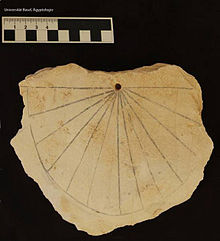
A sundial is a device that indicates time by using a light spot or shadow cast by the position of the Sun on a reference scale.[4] As the Earth turns on its polar axis, the sun appears to cross the sky from east to west, rising at sun-rise from beneath the horizon to a zenith at mid-day and falling again behind the horizon at sunset. Both the azimuth (direction) and the altitude (height) can be used to create time measuring devices. Sundials have been invented independently in every major culture and became more accurate and sophisticated as the culture developed. [5]
- ^ "Preliminary Report on the Work carried out during the season 2013". Archived from the original on 2016-12-28. Retrieved 2016-12-28.
- ^ Bickel, S.; Gautschy, R. Eine ramessidische Sonnenuhr im Tal der Könige. Zeitschrift für Ägyptische Sprache und Altertumskunde 2014, Volume 96, Issue 1, pp. 3–14.
- ^ Vodolazhskaya, L.N. Reconstruction of ancient Egyptian sundials. Archaeoastronomy and Ancient Technologies 2014, 2(2), 1–18.
- ^ Jones 2005, p. 1.
- ^ Jones 2005.